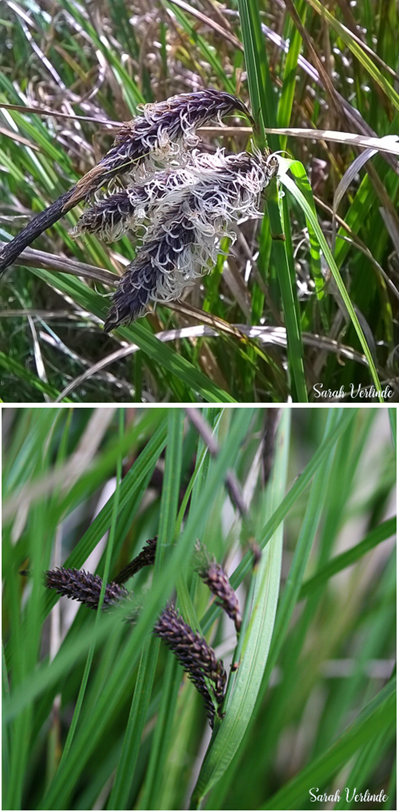Slough sedge
Carex obnupta – Slough sedge
At a Glance:

- Family: Cyperaceae
- Plant Type: Basal, evergreen sedge
- Distribution: Pacific Coast, California to British Columbia
- Habitat: Wetlands, coastal swamps, and along rivers
- Height: 2-4 feet
- Flower/Fruits: Generally, male flowers stick straight up in a spike, while female flowers hang or droop down, below. They are brown-purple in color. At peak bloom, male flowers can be distinguished with yellow pollen, and females have a white sticky web-like substance on them.
- Flowering Season: April – July
- Leaves/Stems: long and grasslike, 3-7mm wide. When vegetative culms (stems) are cut at a cross-section, they make a W shape. When the fertile culms (stems with flowers/fruit) are cut, they have a triangular shape.
- Generation: Perennial
- Notable feature: This is the only evergreen sedge in the area, so if you see it from October to March, it is probably slough sedge.
Restoration and Conservation
Slough sedge helps with erosion control on stream banks. Dense areas of slough sedge help with sediment retention and nutrient uptake which improves water quality overall. In emergent wetland communities slough sedge maintains stream structure, creates a shallow plain where sediment can settle, and provides a nutrient rich habitat for aquatic organisms and waterfowl.
Ethnobotany
The leaves of slough sedge are used to wrap grass baskets that are still made by Nitinaht and Nootka women. The Nitinaht believed that harvesting the slough sedge created fog, so fishermen in the village would get irritated with the women who picked it making it foggy and difficult to sail.
References and Resources
- EMSWCD: https://emswcd.org/slough-sedge
- Jepson Herbarium: http://ucjeps.berkeley.edu/eflora/eflora_display.php?tid=17680
- WTU Image Herbarium: http://biology.burke.washington.edu/herbarium/imagecollection/taxon.php?Taxon=Carex%20obnupta
This article was written by Jessica Rouske and Sarah Verlinde. For questions regarding the UWB/CC Plant Tour, contact Sarah at severlin@uw.edu.
